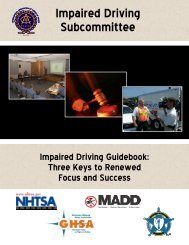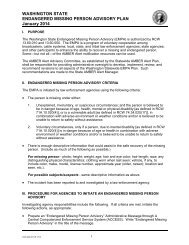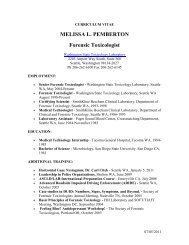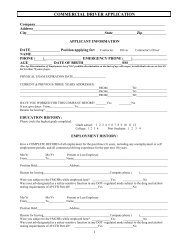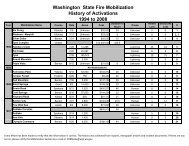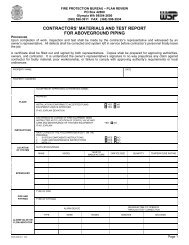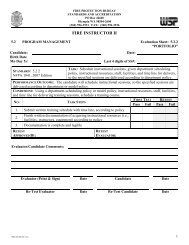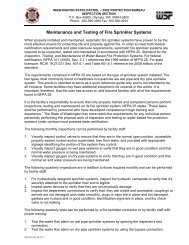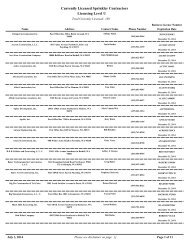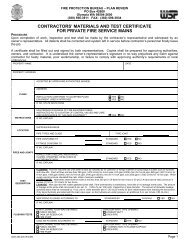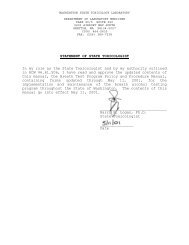Widmark's Equation 03-07-2002 (67 KB PDF)
Widmark's Equation 03-07-2002 (67 KB PDF)
Widmark's Equation 03-07-2002 (67 KB PDF)
Create successful ePaper yourself
Turn your PDF publications into a flip-book with our unique Google optimized e-Paper software.
<strong>Widmark's</strong> <strong>Equation</strong><br />
During the early part of this century, E.M.P. Widmark, a<br />
Swedish physician, did much of the foundational research<br />
regarding alcohol pharmacokinetics in the human body. In<br />
addition, he developed an algebraic equation allowing one to<br />
estimate any one of six variables given the other five.<br />
Typically, we are interested in determining either the amount of<br />
alcohol consumed by an individual or the associated blood alcohol<br />
concentration (BAC) given the values of the other variables.<br />
According to <strong>Widmark's</strong> equation, the amount of alcohol consumed<br />
(A) is a function of these several variables:<br />
N = f(W,r,C t , β , t, z)<br />
<strong>Equation</strong> 1<br />
where:<br />
N = amount consumed<br />
W = body weight<br />
r = the volume of distribution (a constant)<br />
C t<br />
= blood alcohol concentration (BAC)<br />
β = the alcohol elimination rate<br />
t = time since the first drink<br />
z = the fluid ounces of alcohol per drink<br />
<strong>Widmark's</strong> equation relates these variables according to:<br />
Wr(Ct<br />
+ βt)<br />
N =<br />
0.8z<br />
<strong>Equation</strong> 2<br />
where:<br />
N = the number of drinks consumed<br />
W = body weight in ounces<br />
r = volume of distribution (a constant relating the<br />
distribution of water in the body in L/Kg)<br />
C t<br />
= the blood alcohol concentration (BAC) in Kg/L<br />
β = the alcohol elimination rate in Kg/L/hr<br />
t = time since the first drink in hours<br />
z = the fluid ounces of alcohol per drink<br />
0.8 = the density of ethanol (0.8 oz. per fluid ounce)<br />
1
Example 1<br />
Assume that we are interested in determining the amount of<br />
alcohol consumed (number of drinks) given certain information.<br />
The information we are given includes: a male weighing 185 lbs.,<br />
r = 0.68 L/Kg, C t<br />
= 0.15 g/100ml, β = 0.015 g/100ml/hr, t = 5<br />
hours, and drinking 12 fl.oz. beers with 4% alcohol by volume.<br />
We introduce this information into <strong>Equation</strong> 2 according to:<br />
(180lb)(16oz/lb)(0.68L/Kg)(0.0015Kg/L + (0.00015Kg/L/hr)(5hr))<br />
N =<br />
(0.8)(0.48fl.oz./drink)<br />
Notice that we had to convert the 0.15 g/100ml and the 0.015<br />
g/100ml/hr to Kg/L which simply amounts to moving the decimal two<br />
places to the left. Solving for A we find:<br />
1958.4(0.00225)<br />
N =<br />
0.384<br />
=<br />
11.5 drinks<br />
Example 2<br />
The next most common use of <strong>Widmark's</strong> equation is to<br />
determine the blood alcohol concentration (C t<br />
) given the number<br />
of drinks consumed. We now assume the following: a female<br />
weighing 125 lbs., r = 0.55 L/Kg, β = 0.017 g/100ml/hr, t = 4<br />
hours, and consumed 7 one fluid ounce glasses of 80 proof vodka.<br />
Employing <strong>Equation</strong> 1 above we introduce the information we are<br />
given and solve for C t<br />
as follows:<br />
(125lb)(16oz/lb)(0.55L/Kg)(Ct<br />
+ (0.00017Kg/L/hr)(4hr))<br />
7 =<br />
(0.8)(0.40fl.oz./drink)<br />
Notice that we are interested in finding C t<br />
so we rearrange this<br />
equation as follows:<br />
2.24 =1100(Ct<br />
+ 0.00068)<br />
2
Ct<br />
= 0.00136 Kg/L<br />
=<br />
0.136 g/100ml<br />
Uncertainty In Widmark Estimates<br />
Since each variable introduced into <strong>Widmark's</strong> equation is<br />
subject to measurement uncertainty, the computed values will also<br />
have uncertainty propagated through the computations. Widmark<br />
developed two other equations (one for men and one for women)<br />
where he was able to estimate the uncertainty (one standard<br />
deviation) in his computed value for N. His uncertainty<br />
equations are (1):<br />
men<br />
S<br />
N<br />
=<br />
0.015625 N<br />
2<br />
+ 0.050176(N<br />
(0.68Ct<br />
W/0.8z))<br />
2<br />
women<br />
S<br />
N<br />
=<br />
0.01N<br />
2<br />
+ 0.021904(N<br />
(0.55Ct<br />
W/0.8z))<br />
2<br />
Applying the equation for men to our Example 1 above we obtain:<br />
S<br />
N<br />
=<br />
0.015625(11.5)<br />
2<br />
+ 0.050176((11.5)<br />
(0.68)(0.0015)(180)(16)/(0.8)(0.48))<br />
2<br />
Solving for S N<br />
we obtain:<br />
SN<br />
=1.7 drinks<br />
This indicates that the one standard deviation uncertainty for N<br />
is 1.7 drinks and the more commonly employed two standard<br />
deviation estimate would be 3.4 drinks. Thus, our estimate for<br />
the number of drinks in Example 1 above should properly be stated<br />
as:<br />
11.5 ± 3.4 drinks<br />
This is a large and overly conservative estimate of the error in<br />
N. Other work (2,3) suggests that a better estimate of the two<br />
standard deviation estimate in N is closer to ± 20%. For Example<br />
1 the better estimate would be:<br />
11.5 ± 2.3 drinks<br />
3
Using Breath Alcohol Results in <strong>Widmark's</strong> <strong>Equation</strong><br />
Most forensic cases utilizing <strong>Widmark's</strong> equation will employ<br />
breath alcohol rather than blood alcohol results. When doing so,<br />
the breath alcohol concentration (BrAC) must be converted to an<br />
estimated blood alcohol concentration (BAC) before introducing<br />
the value into the equation. This introduces another factor<br />
having uncertainty - the BAC/BrAC conversion factor. Typically,<br />
the breath and corresponding blood alcohol values are assumed to<br />
be the same (using a conversion factor of K bac/brac<br />
= 2100). This is<br />
reasonable in forensic cases since it will typically benefit the<br />
defendant by providing an underestimate of their true BAC by<br />
substituting their BrAC. These principles should be kept in mind<br />
when working with <strong>Widmark's</strong> equation.<br />
References<br />
1. Widmark, E.M.P., Principles and Applications of Medicolegal<br />
Alcohol Determination, Davis, CA: Biomedical Publications,<br />
1981, pp. 1<strong>07</strong>-108.<br />
2. Alha, A. R., "Blood Alcohol and Clinical Inebriation in<br />
Finnish Men: A Medico-legal Study", Ann. Acad. Scientarum<br />
Fennicae, Series A V. Medica-Anthropologica, Vol.26, 1951,<br />
pp. 1-90.<br />
3. Gullberg, R.G. and Jones, A.W., "Guidelines for Estimating<br />
the Amount of Alcohol Consumed From a Single Measurement of<br />
Blood Alcohol Concentration: Re-Evaluation of <strong>Widmark's</strong><br />
<strong>Equation</strong>", Forensic Science International, Vol.69, 1994,<br />
pp. 119-130.<br />
RGG 3/7/<strong>2002</strong><br />
4



